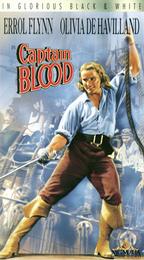Captain Blood
B&W, 119 minutes, released December 1935 by Warner Bros.
DIRECTOR: Michael Curtiz
PRODUCER: Hal B. Wallis for Warner Bros.
CAST:
Peter Blood -- Errol Flynn
Arabella Bishop -- Olivia de Havilland
Levasseur -- Basil Rathbone
Colonel Bishop -- Lionel Atwill
Jeremy Pitt -- Ross Alexander
Hagthorpe -- Guy Kibbee
Lord Willoughby -- Henry Stephenson
Wolverstone -- Robert Barrat
Dr. Bronson -- Hobart Cavanaugh
Dr. Whacker -- Donald Meek
Cahusac -- J. Carrol Naish
Don Diego -- Pedro de Cordoba
Governor Steed -- George Hassell
Kent -- Harry Cording
Baron Jeffreys -- Leonard Mudie
King James -- Vernon Steele
Honesty Nuthall -- Forrester Harvey
Reverend Ogle -- Frank McGlynn
Andrew Baynes -- David Torrence
Captain Hobart -- Stuart Casey
Court Clerk -- E.E. Clive
Lord Sunderland -- Halliwell Hobbes
ABSTRACT: This is a swashbuckler-pirate adventure film in which Doctor Peter Blood (Errol Flynn) rebels against King James II (Vernon Steele) who has him deported from England to Jamaica as a slave. Once there, he is purchased by Colonel Bishop (Lionel Atwill) at the insistence of his niece Arabella (Olivia de Havilland). Blood fights against his slavery, becomes romantically involved with Arabella, and ultimately saves the city.
CHARACTERISTICS OF THE ADVENTURE GENRE:
(from Brian Taves, The Romance of Adventure, 1993)
- There are 5 types of adventure films: swashbuckler, pirate, sea, empire, fortune hunter.
- The four cycles of the adventure genre are 1920-29, 1934-40, 1945-60, 1973-1981.
- The use of history is the foremost element of the genre, providing an exotic and remote setting, an emphasis on heroic deeds and definitive battles, an authentic and believable story, a lesson that history has meaning and purpose, with characters that become catalysts for progress, able to shape destiny out a defining crisis. The historical theme sometimes is so strong that it becomes deterministic, and the characters act as if they are agents of destiny. History becomes legend and myth and fable, a vehicle for moral tales of virtue and valor.
- Action and mise-en-scene are essential to the adventure genre. The placing of characters on sailing ships, on pirate islands, riding horses, swimming, running on the beach, is crucial to the narrative's structure and creates an authentic alternative reality that gives the genre its epic nature.
- The theme of violence is personalized and stylized, usually with the sword in hand-to-hand combat. Battles are choreographed and progressive, emphasizing thrill and victory rather than terror and death.
- The adventure hero is a whole person, ideal in all aspects, attractive, chivalrous, romantic, nimble, quick-thinking, able to use disguise, lively, courageous, able to earn loyalty of followers and love of women, and in general personifies the mythical ideals of the culture.
- The villain portrays the opposite traits of the hero, disrupts peaceful lives, causes war, personifies the failings of the culture. The conflict between protagonist and antagonist is clear and central to the narrative.
- Women are the attractive but meek recipients of the hero's attentions. Although not helpless, they are submissive, respectable, nonthreatening. The political triumph at the end is tied in some way to romantic fulfillment.
- The adventurers' code of conduct is central to the behavior of the hero and his followers. It defines the difference between hero and villain, provides motive and causation, justifies violence. The code mandates honor, duty, loyalty, selflessness, even spirituality. The hero's values are from instinct and conscience, not written law. He may make mistakes, but they are always corrected. Patriotism and love of country are strong motives, usually to redress tyranny or the misuse of political power. Class lines are fluid and the hero may be a gentleman or aristocrat by birth, but he is not exclusive or elitist.
- Politics is an important theme. Revolution and rebellion are part of the narrative, and the closure involves rebirth and renewal of a new political order. The characters must undergo a quest or odyssey to find the solution to their problems, they must show their new collective loyalty to each other, and win their freedom and liberty.
Links:
revised 1/12/99 |Class Page

